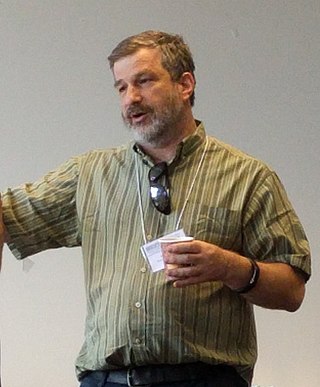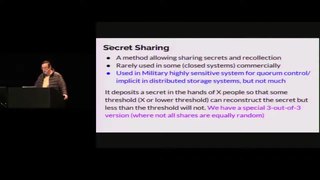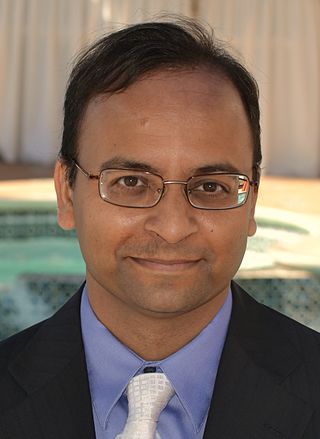In cryptography, a random oracle is an oracle that responds to every unique query with a (truly) random response chosen uniformly from its output domain. If a query is repeated, it responds the same way every time that query is submitted.
In cryptography, an oblivious transfer (OT) protocol is a type of protocol in which a sender transfers one of potentially many pieces of information to a receiver, but remains oblivious as to what piece has been transferred.
A cryptographic protocol is an abstract or concrete protocol that performs a security-related function and applies cryptographic methods, often as sequences of cryptographic primitives. A protocol describes how the algorithms should be used and includes details about data structures and representations, at which point it can be used to implement multiple, interoperable versions of a program.
Secure multi-party computation is a subfield of cryptography with the goal of creating methods for parties to jointly compute a function over their inputs while keeping those inputs private. Unlike traditional cryptographic tasks, where cryptography assures security and integrity of communication or storage and the adversary is outside the system of participants, the cryptography in this model protects participants' privacy from each other.
Provable security refers to any type or level of computer security that can be proved. It is used in different ways by different fields.
In cryptography, a password-authenticated key agreement (PAK) method is an interactive method for two or more parties to establish cryptographic keys based on one or more parties' knowledge of a password.
The Diffie–Hellman problem (DHP) is a mathematical problem first proposed by Whitfield Diffie and Martin Hellman in the context of cryptography and serves as the theoretical basis of the Diffie–Hellman key exchange and its derivatives. The motivation for this problem is that many security systems use one-way functions: mathematical operations that are fast to compute, but hard to reverse. For example, they enable encrypting a message, but reversing the encryption is difficult. If solving the DHP were easy, these systems would be easily broken.
In cryptography the standard model is the model of computation in which the adversary is only limited by the amount of time and computational power available. Other names used are bare model and plain model.
In computational complexity theory, a computational hardness assumption is the hypothesis that a particular problem cannot be solved efficiently. It is not known how to prove (unconditional) hardness for essentially any useful problem. Instead, computer scientists rely on reductions to formally relate the hardness of a new or complicated problem to a computational hardness assumption about a problem that is better-understood.
Secure two-party computation (2PC) a.k.a. Secure function evaluation is sub-problem of secure multi-party computation (MPC) that has received special attention by researchers because of its close relation to many cryptographic tasks. The goal of 2PC is to create a generic protocol that allows two parties to jointly compute an arbitrary function on their inputs without sharing the value of their inputs with the opposing party. One of the most well known examples of 2PC is Yao's Millionaires' problem, in which two parties, Alice and Bob, are millionaires who wish to determine who is wealthier without revealing their wealth. Formally, Alice has wealth , Bob has wealth , and they wish to compute without revealing the values or .

Moni Naor is an Israeli computer scientist, currently a professor at the Weizmann Institute of Science. Naor received his Ph.D. in 1989 at the University of California, Berkeley. His advisor was Manuel Blum.
Non-interactive zero-knowledge proofs are cryptographic primitives, where information between a prover and a verifier can be authenticated by the prover, without revealing any of the specific information beyond the validity of the statement itself. This makes direct communication between the prover and verifier unnecessary, effectively removing any intermediaries.
Nigel Smart is a professor at COSIC at the Katholieke Universiteit Leuven and Chief Academic Officer at Zama. He is a cryptographer with interests in the theory of cryptography and its application in practice.

Mordechai M. "Moti" Yung is a cryptographer and computer scientist known for his work on cryptovirology and kleptography.
Jonathan Katz is a professor in the Department of Computer Science at the University of Maryland who conducts research on cryptography and cybersecurity. In 2019–2020 he was a faculty member in the Volgenau School of Engineering at George Mason University, where he held the title of Eminent Scholar in Cybersecurity. In 2013–2019 he was director of the Maryland Cybersecurity Center at the University of Maryland.

Tal Rabin is a computer scientist and Professor of Computer and Information Science at the University of Pennsylvania and a Director at Amazon Web Services (AWS). She was previously the head of research at the Algorand Foundation and the head of the cryptography research group at IBM's Thomas J. Watson Research Center.

Amit Sahai is an Indian-American computer scientist. He is a professor of computer science at UCLA and the director of the Center for Encrypted Functionalities.
Chandrasekaran Pandurangan is a computer scientist and academic professor of the Computer Science and Engineering Department at Indian Institute of Technology - Madras (IITM). He mainly focuses on the design of pragmatic algorithms, graph theory and cryptography.
Garbled circuit is a cryptographic protocol that enables two-party secure computation in which two mistrusting parties can jointly evaluate a function over their private inputs without the presence of a trusted third party. In the garbled circuit protocol, the function has to be described as a Boolean circuit.

Private set intersection is a secure multiparty computation cryptographic technique that allows two parties holding sets to compare encrypted versions of these sets in order to compute the intersection. In this scenario, neither party reveals anything to the counterparty except for the elements in the intersection.





